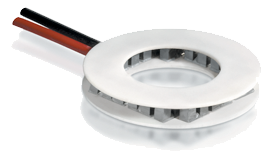New thermoelectric generator converts vehicle exhaust heat into electricity, boosting fuel efficiency
-
Would be cool if Laird or one of the other thermoelectric ceramic (TEC) manufacturers made cylindrical TECs. So far I’ve only seen them be flat and square. TECs are very brittle too so vibration if that tail pipe would have to be dealt with for them but to break
-
Was also terribly expensive. The performance to cost wasn't worth it even for F1
-
Only getting rid of them next year I'm pretty sure. And initial problems of reliability but not these days. With phenomenal thermal efficiency from tiny engines
-
Do alternators fail that often?
-
Would be cool if Laird or one of the other thermoelectric ceramic (TEC) manufacturers made cylindrical TECs. So far I’ve only seen them be flat and square, or they cut the flat square out like this

instead of in the radial direction, not axial. There are some made for research but not commercially available as far as I’ve been able to find.

Also TECs are very brittle too so vibration if that tail pipe would have to be dealt with for them not to crack. I’ve cracked a few myself but i use for machine design, not on my car.
-
Nope. It does suck when they do.
-
I thought turbos converted air (exhaust) kinetic energy into mechanical energy, not the heat itself. If exhaust was cold, the turbo would still work, no?
Not saying that these Peltier devices are going to be game changers, but it sounds like they do something different from turbos in that they are capturing additional wasted energy.
-
Not enough power to affect anything
-
Yes, and no. Heat and kinetic energy are fundamentally all just energy. What we call heat is, technically, the kinetic energy of molecules vibrating around.
When exhaust gas passes through a turbocharger, it is both slowed and reduced in pressure, resulting in it being slightly cooler than when it entered. This device is using a different method of getting energy out of the exhaust gas, but it's fundamentally still the kinetic energy of those very energetic exhaust gas molecules bouncing against one side of the thermoelectric generator and giving up their energy into it. I would still expect the exhaust gas to come out of it slightly cooler and slower.
-
This type of technology and the concepts of energy conservation and recovery are so damn cool.
-
Fools logic. This is a single system imagine the world running systems like this on every device or system, then the amount adds up. Energy recovery is the future. Maximizing what we can produce. Sustainability.
-
Gotcha, thanks. It doesn't sound particularly revolutionary as far as energy capture goes, since 40W is probably negligible on today's cars.
NGL though, on an old '75 Honda motorcycle I used to own, an extra 40W would have been amazing. The alternator was too tiny to keep the electronics running and battery charged, and I had to turn the headlight off whenever possible to keep the battery charging.
-
What we call heat is, technically, the kinetic energy of molecules vibrating around
I’ve wondered about this. If this is so, and heat is molecules moving back and forth, how do the molecules stop, change direction, and then accelerate in the other direction, stop, change directions again, and go back, over and over and over?
-
It even says in the article 40 watts. I’m not going to say this affects literally nothing, but it is not a significant enough amount of power to meaningfully affect the locomotion of a car. It might make more sense in much more scaled up helicopters and planes where fuel economy is a far bigger problem. But thermoelectric has never been a very potent method.
-
Wouldn't be powerful enough actually. You're better off having a battery that's in good condition. I've done nearly 100 km with the alternator belt off. It being a diesel, it didn't need to fire sparks though.
-
I remember when I first learned about regenerative braking when the first Priuses were coming out. Shit blew my mind.
-
We already do this at every steam based power plant in the world (basically everything but hydro, PV, and wind) and it's done much more efficiently. Doing this stuff with tiny gadgets on micro generators like ICE vehicles is a pretty inefficient implementation, especially as it adds weight to already heavy vehicles, decreasing efficiency and safety, and increasing tire and brake wear. The only place I can imagine this being useful is very heavy vehicles that for some reason still have to be using diesel like long haul trucks/busses, diesel freight trains etc and the like. And EVEN then you're looking at major issues with economy. If you increase the weight of a truck by 2 percent to give it a 2% increase in fuel efficiency, you are hurting not helping. 2% comes off of your GCVWR margins and suddenly you need 51 trucks instead of 50 trucks to transport a given load, not only increasing your fuel use by 2% but also increasing vehicle maintenance and tire and brake pollution by 2%
-
Your explanation about where the energy comes from with turbochargers sounds wrong to me.
When exhaust gas passes through a turbocharger,
You're skipping a crucial step here. The exhaust gases get pushed through input of the exhaust gas impeller on the turbocharger by the movement of a piston in the engine during the exhaust cycle. This "work" isn't free. Its energy that comes from the other pistons on their combustion cycle. If there is more resistance on the exhaust coming out of the engine (which there is to drive the turbocharger impeller), that energy must be added (robbed) by the energy at the crankshaft that ultimately powers the wheels.
The extra boost of power we experience in an engine from using a turbocharger is that the turbocharger allows more oxygen to be put into the combustion chambers (and the engine puts more fuel in at the same time). The extra energy is from burning - - more fuel in the same period of time than without turbocharging. The fuel is the source of the energy, the turbocharger isn't recovering any energy.
The article is covering technology is actually recovering energy turning heat (thermal energy) back into electricity (electrical energy).
-
Molecules interact with each other. Energy is transferred as they bump around. If you were to follow a single molecule it would move around randomly. What we can measure is usually the average of many molecules.
-
Show this to any automotive engineer and count how many seconds before they start laughing


